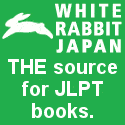Something that starts to get more and more difficult about the JLPT as you go up in the levels is the reading section. It starts off being deceptively easy at the N5 level, becomes a little more difficult with N4 and N3, and starts to become a major part of the test at the N2 and N1 levels.
To add insult to injury the test contains some reading that is often times a bit difficult to find if you aren’t taking a class at a Japanese university. Sure, if you are living in Japan, you can find plenty of advertisements and brochures that are very similar to the informational retrieval questions, but it can be a little more difficult to find the essays and opinion pieces that are written for your level.
So-Matome’s Solution to the Problem
The Nihongo So-Matome series of books are one of my favorite tools to help conquer this problem. If you are not familiar with the series, these are a books for the N3~N1 levels of the test and have 4 books for each level, kanji, vocabulary, grammar and reading comprehension. I went over the Nihongo So-Matome N2 Grammar Book in an earlier post.
These books are very user-friendly and contain just enough hand-holding to get through what you need to learn for the test. You will have to go back and review these books often, but after I went through them I’ve felt well-prepared for the exams.

How the Nihongo So-Matome N2 Reading Comprehension Book is Organized
Each unit starts off with a small set of key phrases or some tips or strategies to use for that particular type of question for the test. These can be quite useful because they will cover some of the major traps that you can fall into in the reading section. It also goes over specialized vocabulary that is only used in written Japanese.
After this small lesson, it introduces the reading passage of the day with a short conversation. This is a little bit of listening and reading practice rolled into one. I say listening because the conversation uses a lot of conversational language, but also it follows the same back and forth twisting style that you will see on the listening section of the test. In other words, the answer to the questions won’t be as clear as day, you will have to read both sides of the conversation and figure out what is being said.
After this introductory conversation, it gives you 5 statements and you must choose the statements that are correct (usually 2 or 3 of them). This question format is actually similar to a type of question that is often asked on the test as well, so it is good reading practice and answering practice.
On the second page of each day, there is a reading question like what you will see on the exam either a reading passage and questions or an information retrieval question. In either case, there are only 2 questions and all words that are not standard N2 vocabulary will be defined in English (and Chinese and Korean).
The book covers all the major types of questions that have been known to come up. This includes information retrieval questions, where you search for the information in a brochure or advertisement as well as essays, opinions, newspaper articles, editorials and novels. If you are wondering about the last one, they aren’t actual 300 page novels on the test, just excerpts from novels.
Nihongo So-Matome N2 Reading Comprehension Review Units
These units come on the 7th day of every week in the 6 week course and have about 4 to 6 questions. These are examples of questions that will appear on the test. In this section, all the words that are not standard N2 vocabulary will only be defined in Japanese, which can make this unit more difficult than the other units.
What I Like about It
It gives you more than just practice for the test. This book helps you through reading comprehension in general, so even if you aren’t interested in passing the test, it can help you with your overall reading comprehension. It also has a easy-to-follow user-friendly 6 week format that helps you get through the book and not meander about through it slowly. I can get my unit done for the day and relax knowing that I’m finished.
What I Don’t Like about It
The daily units can actually be a bit too easy sometimes. I did the old book for nikyuu and was able to complete the exercises fairly easily in the book, but when I got to the test, I didn’t do so well. This lulled me into a bit of false security.
My tip to avoid this is to time yourself for the daily units. This way you get use to reading the passages and answering the questions under pressure. Don’t give yourself 30 minutes to complete each unit, see if you can get them done in 15 to 20 minutes instead. This will prepare you for test conditions as well as add an extra challenge.
Overall
I think this is an invaluable book if you are studying for the N2 and don’t have a lot of reading practice. The reading section of this test is one of the things I hear the most questions about. You will definitely have to increase your reading speed and skill in order to pass this section of the exam.
If you are interested in picking it up, I recommend the two following places depending on if you are in or out of Japan:
Out of Japan, try White Rabbit Press
In Japan, try Amazon.co.jp











Hello Mac! I like a lot your blog :D, I´m Colombian and I´m interested in purchasing some books of So-matome series and New Kanzen master but I thought to purchase out of Japan I needed to use “Amazon” and you wrote “In Japan, try Amazon.co.jp”. I´m a little confused xD.
Amazon.co.jp is probably the cheapest place to get it if you are in Japan, but if you are outside of japan, you can use White Rabbit Press. They offer pretty good deals outside the country.